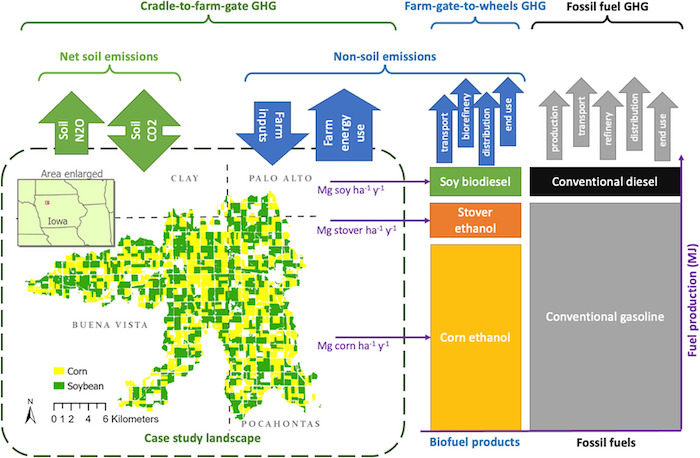Researchers from multiple national laboratories have found that collecting corn residue for ethanol-based fuel could improve the amount of carbon mitigation your fields can provide.
A study published in the Journal of Cleaner Production found that harvesting up to 30% of corn stover on a field for use in fuel products could increase revenues for growers and decrease the negative impact on the environment, while at the same time allowing some soil organic matter accumulation.
Models used in the study suggest an additional reduction of 0.29 metric tonnes of carbon dioxide equivalent per year.
The study was based on county-level data previously collected on corn and soybean farms in Clay, Palo Alto, Buena Vista and Pocahontas counties in Northwestern Iowa. Using the data, they created a baseline scenario labeled "BAU" for "Business As Usual."
Researchers then modeled potential changes to practices using computers, and compared those with the BAU scenario. They modeled various emissions based on no stover removal and the 30% figure, then split those into two groupings based on whether or not cover crops were planted, then split those subcategories to examine changes in tillage, for a total modeling of 12 different scenarios.
"Landscape intensification via stover removal on its own or in association with moderate tillage intensity reduction leads to a reduced rate of soil organic content (SOC) sequestration compared to the BAU scenario," researchers wrote. "However, all stover removal scenarios with no-till adoption, cover crop addition, or various combinations thereof achieved greater SOC sequestration rates than BAU."
Ultimately, combining stover harvest with no-tillage — one of several "natural solutions" suggested — produced the best total outcome, because the stover harvest, when processed into ethanol, offset emissions issued by burning conventional fossil fuels.
"We find that the greenhouse gas mitigation value of corn stover harvest for biofuel production is generally higher than the SOC sequestration value of leaving the stover in place," they wrote. "Results suggest synergies can be achieved when they are combined. In scenarios where stover removal is paired with the adoption of either no-till management alone or reduced tillage plus winter cover-cropping, those conservation measures cancel out the soil carbon opportunity cost of the stover collection, and the additional revenues from stover biomass more than offset the costs of the conservation measures."
Researchers on the paper included Trung H. Nguyen of the Queensland University of Technology and Colorado State University, John L. Field of Colorado State and the Oak Ridge National Laboratory, Hoyoung Kwon of the Argonne National Laboratory, Troy Hawkins of Argonne, Keith Paustian of Colorado State, and Michael Wang of Argonne.








Post a comment
Report Abusive Comment